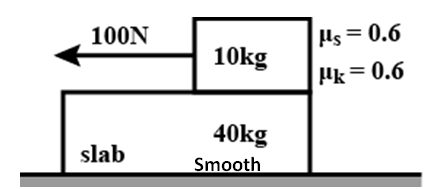
Answer
103.8k+ views
Hint We first need to check if 100N of force is sufficient to move the top block, if it is, then the block will accelerate in the direction of the force, else there will be relative motion between the blocks. The force acting on the lower block will be the force due to limiting friction between the 10kg and 40kg block.
Complete step by step solution
100N force is acting on the top block which is 10kg. the limiting friction to move this block will
\[f\, = \,\mu 10g\]
\[f\, = \,0.6\,\times\,10\,\times\,9.81\]
\[f\, = \,58.6{\text{ }}N\]
As \[100 > {\text{ }}58.6\] , the upper block will move with the force, and the lower block will move in the opposite direction
Net forces acting on the lower block is equal to 58.6N in the opposite direction, therefore the acceleration of the lower block is:

\[
58.6\, = \,40a \\
a\, = \,\dfrac{{58.6}}{{40}} \\
a{\text{ }} = {\text{ }}1.46 \\
\]
Therefore no option is correct in this question
Note If there was friction between the lower block and ground, the net force would be the difference of the force due to the upper block and force of friction due to the lower block.
Complete step by step solution
100N force is acting on the top block which is 10kg. the limiting friction to move this block will
\[f\, = \,\mu 10g\]
\[f\, = \,0.6\,\times\,10\,\times\,9.81\]
\[f\, = \,58.6{\text{ }}N\]
As \[100 > {\text{ }}58.6\] , the upper block will move with the force, and the lower block will move in the opposite direction
Net forces acting on the lower block is equal to 58.6N in the opposite direction, therefore the acceleration of the lower block is:

\[
58.6\, = \,40a \\
a\, = \,\dfrac{{58.6}}{{40}} \\
a{\text{ }} = {\text{ }}1.46 \\
\]
Therefore no option is correct in this question
Note If there was friction between the lower block and ground, the net force would be the difference of the force due to the upper block and force of friction due to the lower block.
Recently Updated Pages
Write a composition in approximately 450 500 words class 10 english JEE_Main

Arrange the sentences P Q R between S1 and S5 such class 10 english JEE_Main

Write an article on the need and importance of sports class 10 english JEE_Main

Name the scale on which the destructive energy of an class 11 physics JEE_Main

Choose the exact meaning of the given idiomphrase The class 9 english JEE_Main

Choose the one which best expresses the meaning of class 9 english JEE_Main

Other Pages
Formula for number of images formed by two plane mirrors class 12 physics JEE_Main

A physical quantity which has a direction A Must be class 11 physics JEE_Main

If a wire of resistance R is stretched to double of class 12 physics JEE_Main

Electric field due to uniformly charged sphere class 12 physics JEE_Main

For pure water A pH increases while pOH decreases with class 11 chemistry JEE_Main





